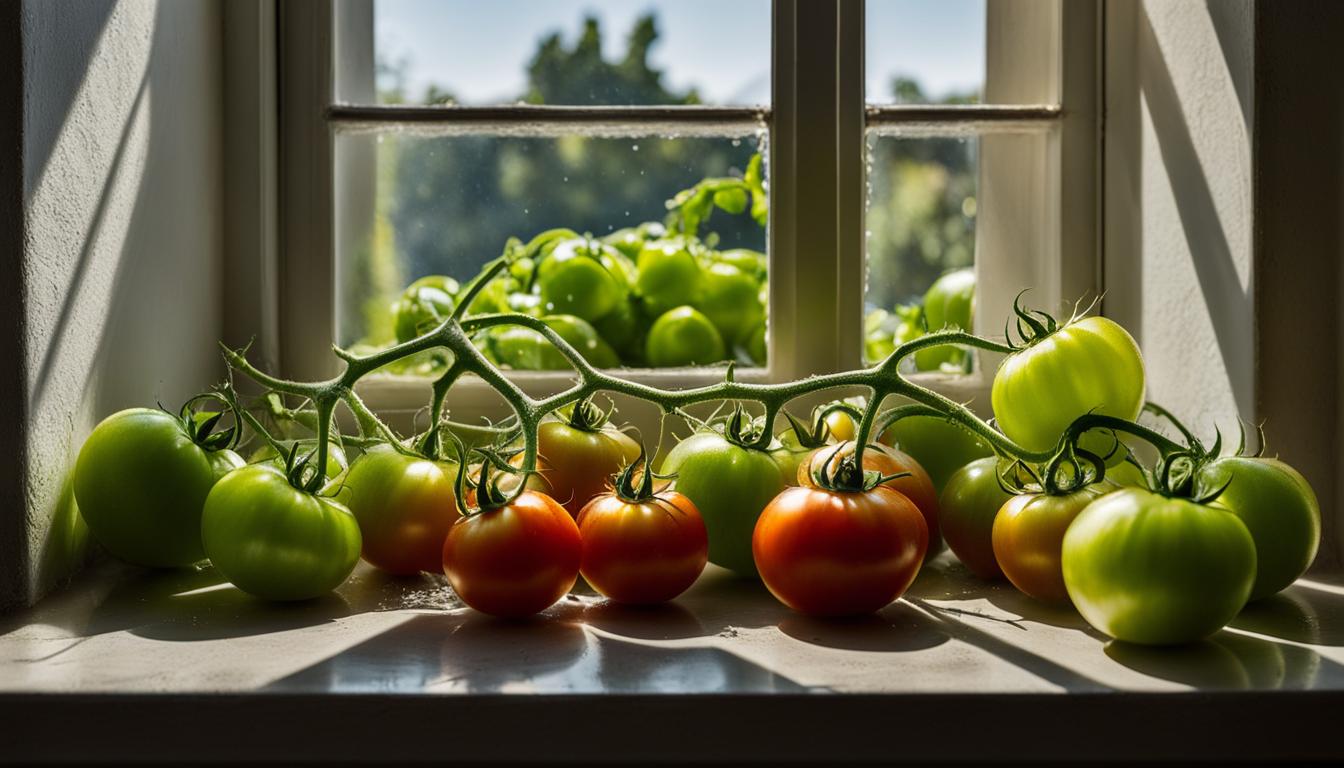Waiting for tomatoes to ripen can feel like a never-ending process. The ripening of tomatoes depends on several factors, including temperature, exposure to sunlight, and the production of a natural hormone called ethylene.
Temperature plays a crucial role in ripening tomatoes, with the ideal range being 68 to 77 degrees Fahrenheit. Too much heat above 85 degrees can halt ripening, while temperatures below 60 degrees also inhibit the process. Additionally, excessive sun exposure can slow down ripening, and overwatering can redirect the plant’s energy away from ripening.
Providing the right balance of nutrients, such as phosphorous and potassium, is essential for promoting lycopene production and proper ripening. Pruning the plant to remove unproductive vines and ensuring that the tomatoes are the correct variety and at the right stage of ripeness are also important factors to consider when waiting for tomatoes to turn red.
Key Takeaways:
- The ripening of tomatoes depends on temperature, sunlight exposure, and hormone production.
- The ideal temperature range for ripening tomatoes is 68 to 77 degrees Fahrenheit.
- Excessive heat above 85 degrees or temperatures below 60 degrees can inhibit ripening.
- Providing the right balance of nutrients is crucial for promoting lycopene production.
- Pruning the plant and ensuring the correct variety and ripeness stage are important factors for successful ripening.
Factors Affecting Tomato Ripening Time
Understanding the factors that influence the ripening time of tomatoes can help you anticipate when your green tomatoes are likely to turn red. These factors include the tomato variety, growing zone, and environmental conditions.
Tomato variety plays a significant role in ripening time. Smaller varieties like cherry tomatoes generally ripen faster than larger beefsteak tomatoes. The ripening process typically takes about 6-8 weeks after the flowers have been pollinated.
The temperature range is another crucial factor in tomato ripening. For optimal ripening, tomatoes require temperatures between 50 to 85 degrees Fahrenheit. Temperatures above 85 degrees or below 50 degrees can delay or halt the ripening process. It’s important to monitor the temperature in your growing area and make adjustments if needed.
Other environmental conditions such as sunlight exposure and the plant’s health can also affect the ripening time. Providing the right balance of sunlight and shade can help regulate the ripening process. Additionally, ensuring the tomato plant is pruned properly and receives adequate nutrients will contribute to successful ripening.
Factors Affecting Tomato Ripening Time:
| Factor | Effect on Ripening Time |
|---|---|
| Tomato Variety | Different varieties have different ripening times, with smaller tomatoes typically ripening faster. |
| Temperature | Temperatures within the range of 50 to 85 degrees Fahrenheit promote optimal ripening, while extreme temperatures can slow down or halt the process. |
| Environmental Conditions | Sunlight exposure, plant health, and nutrient levels all play a role in the ripening time of tomatoes. |
By considering these factors, you can better understand when your tomatoes are likely to reach their ripe, red stage. This knowledge will help you plan and care for your tomato plants accordingly to ensure a successful harvest.
Tips for Accelerating Tomato Ripening
If you’re eager for your green tomatoes to turn red, there are several tricks you can try to accelerate the ripening process. Here are some tips to help you ripen tomatoes on the vine faster:
- Topping off the tomato plant: By cutting off the main stem, you can redirect the plant’s energy towards ripening the existing fruit.
- Providing shade: During hot temperatures, providing shade to the plants can help prevent excessive heat from inhibiting ripening.
- Regularly harvesting slightly ripe fruit: When you notice any slightly ripe tomatoes, harvest them promptly. This action can encourage the remaining fruit to ripen more quickly.
- Pinching off suckers: Suckers are smaller stems that grow between branches. By pinching them off, you redirect the plant’s energy to the maturing fruit.
- Removing new flowers: If your tomato plant continues to produce new flowers, removing them can direct energy toward ripening the existing fruit.
- Reducing watering: As the fruit matures, reducing watering can channel the plant’s energy into ripening instead of new growth.
Implementing these tips can help expedite the ripening process, especially as the end of the growing season or colder temperatures approach.
Table: Comparing Different Tomato Ripening Techniques
| Technique | Effectiveness | Effort Required | Recommended Situations |
|---|---|---|---|
| Topping off the plant | High | Low | When few fruits remain |
| Providing shade | Moderate | Medium | During hot temperatures |
| Regularly harvesting ripe fruit | Moderate | High | When multiple fruits are present |
| Pinching off suckers | Low | Medium | Throughout the growing season |
| Removing new flowers | Low | Low | When focusing on fruit ripening |
| Reducing watering | Moderate | Low | During the final stages of ripening |
Using these techniques can help you achieve faster tomato ripening and enjoy a delicious harvest of red, ripe tomatoes.

What to Do with Green Tomatoes that Won’t Ripen
Despite your best efforts, some of your green tomatoes may refuse to turn red. Don’t worry, there are still plenty of options for utilizing these vibrant green fruits. One option is to harvest the green tomatoes once frost arrives and bring them indoors. Tomatoes that have already started to show a slight blush of color have a high chance of fully ripening indoors. Place them in a cool, dark area and check on them regularly as they continue to ripen.

For those green tomatoes that remain completely unripe, there are several creative ways to put them to good use. One popular method is pickling. With their firm texture and tangy flavor, green tomatoes make a delicious addition to pickling recipes. You can pickle them whole, slice them, or even turn them into relish or chutney. Another option is to incorporate green tomatoes into recipes that call for unripe fruits, such as green tomato pie or green tomato salsa. These recipes highlight the unique flavor profile of green tomatoes and can be a delightful culinary adventure.
If you have a surplus of green tomatoes that won’t ripen, consider sharing them with others. Friends, family, and neighbors might be interested in trying their hand at cooking or pickling green tomatoes. You can also donate your unripe tomatoes to local food banks or community gardens. It’s a great way to reduce food waste and support others in their culinary endeavors.
| Ways to Use Green Tomatoes | Description |
|---|---|
| Pickling | Green tomatoes are perfect for pickling due to their firm texture and tangy flavor. They can be pickled whole or sliced and make a great addition to sandwiches, salads, and charcuterie boards. |
| Recipes | Experiment with recipes that specifically call for unripe tomatoes, such as green tomato pie or green tomato salsa. These dishes showcase the unique flavor of green tomatoes and provide a delicious alternative to traditional ripe tomato recipes. |
| Sharing and Donation | If you have an abundance of green tomatoes, consider sharing them with friends, family, or neighbors who may be interested in experimenting with them. Additionally, you can donate your unripe tomatoes to local food banks or community gardens to help reduce food waste and support others in need. |
Remember, even if your green tomatoes don’t ripen as expected, there are still plenty of ways to enjoy their unique flavor and prevent them from going to waste. Get creative in the kitchen and explore the culinary possibilities of green tomatoes!
Conclusion – Ensuring Successful Tomato Ripening
Congratulations on your journey to ripen your green tomatoes! Remember, patience is key when it comes to successful tomato ripening. By understanding the impact of factors like temperature, sunlight exposure, hormone production, and nutrient balance, you can take steps to ensure the best possible results.
Implementing techniques such as topping off the plant, providing shade during hot temperatures, and managing water and nutrient levels can help accelerate the ripening process. However, it’s important to allow tomatoes to ripen at their own pace, taking into account their variety and the climate in which they are grown. The right balance of care and attention will lead to a bountiful harvest of delicious, ripe tomatoes.
In summary, here are some tips for ripening tomatoes on the vine:
1. Create the Ideal Environment:
Optimize the temperature range between 68 and 77 degrees Fahrenheit. Provide adequate sunlight, but avoid excessive exposure. Ensure the plant receives the right nutrients, such as phosphorous and potassium, to promote lycopene production and proper ripening.
2. Employ Smart Gardening Techniques:
Prune unproductive vines to redirect energy to the maturing fruit. Remove suckers and new flowers to focus the plant’s energy on ripening. Reduce watering as the fruit matures to channel energy into ripening rather than new growth.
3. Be Patient and Observant:
Remember that tomatoes ripen at their own pace. Take into account the variety and the climate of your growing zone. Monitor the tomatoes regularly, harvest slightly ripe ones to encourage the rest to ripen, and be prepared to bring green tomatoes indoors before frost arrives.
With these tips and a little TLC, you’ll soon be enjoying the taste of ripe, juicy tomatoes straight from your own garden. Happy gardening!
Zaki Infitar is the driving force and creative mind behind GreenBuilt.co. As a self-taught gardener with an unwavering passion for all things green, Zaki’s journey into the world of gardening is a testament to his dedication and love for nature.

